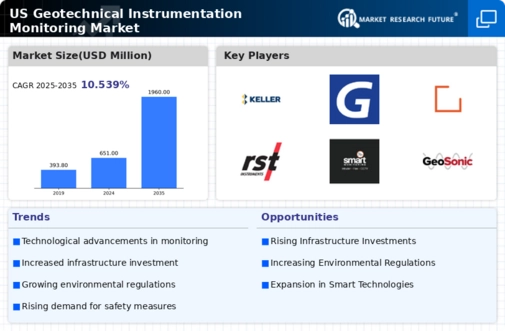Regulatory Framework Enhancements
The market is influenced by the evolving regulatory framework surrounding construction and environmental safety. Stricter regulations and guidelines necessitate the implementation of advanced monitoring systems to ensure compliance with safety standards. Agencies such as the Environmental Protection Agency (EPA) and the Occupational Safety and Health Administration (OSHA) are increasingly mandating the use of geotechnical monitoring to prevent accidents and environmental degradation. This regulatory push is likely to drive market growth, as companies invest in reliable monitoring solutions to adhere to compliance requirements and avoid potential penalties.
Increased Infrastructure Development
The ongoing infrastructure development initiatives in the US are significantly impacting the geotechnical instrumentation-monitoring market. With substantial investments in transportation, energy, and urban development projects, the need for effective monitoring solutions is paramount. The Federal Infrastructure Investment and Jobs Act, which allocates $1.2 trillion for infrastructure improvements, is expected to create a favorable environment for the market. As construction projects become more complex, the demand for reliable geotechnical monitoring systems to ensure safety and compliance is likely to rise. This trend suggests a strong correlation between infrastructure spending and the growth of the geotechnical instrumentation-monitoring market.
Growing Awareness of Geotechnical Risks
There is a growing awareness of geotechnical risks among stakeholders in construction and civil engineering sectors. This heightened awareness is driving the demand for comprehensive monitoring solutions to identify potential hazards such as soil instability and groundwater fluctuations. As organizations prioritize risk management, the geotechnical instrumentation-monitoring market is likely to benefit from increased investments in monitoring technologies. The emphasis on proactive risk assessment and mitigation strategies is expected to lead to a market growth rate of around 7% annually, reflecting the importance of geotechnical monitoring in safeguarding infrastructure projects.
Rising Demand for Sustainable Practices
The emphasis on sustainable construction practices is shaping the geotechnical instrumentation-monitoring market. As organizations strive to minimize their environmental footprint, there is a growing demand for monitoring solutions that support sustainable development. Technologies that enable efficient resource management and reduce waste are becoming increasingly popular. The integration of geotechnical monitoring systems with sustainable practices not only enhances project efficiency but also aligns with corporate social responsibility goals. This trend indicates a potential market growth of approximately 6% over the next few years, as more companies adopt sustainable monitoring solutions.
Technological Advancements in Monitoring Equipment
The geotechnical instrumentation-monitoring market is experiencing a surge in technological advancements, particularly in sensor technology and data analytics. Innovations such as wireless sensors and IoT integration are enhancing the efficiency and accuracy of monitoring systems. For instance, the adoption of real-time data collection methods allows for immediate analysis and response to geotechnical changes. This trend is likely to drive market growth, as companies increasingly seek to implement advanced monitoring solutions to mitigate risks associated with construction and infrastructure projects. The market is projected to grow at a CAGR of approximately 8% over the next five years, indicating a robust demand for cutting-edge monitoring technologies.























Leave a Comment